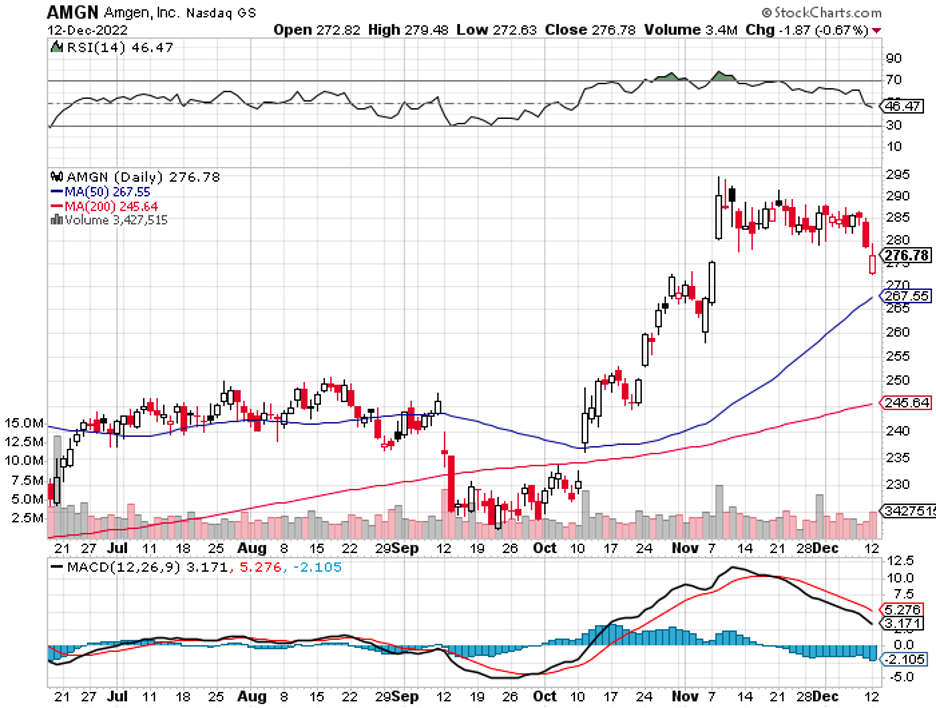Amgen (AMGN) announced what could be the biggest M&A deal in the biotechnology world this 2022.
The giant biotech disclosed its deal to acquire Horizon Therapeutics (HZNP) for $27.8 billion in cash, amounting to roughly $116.50 per share which is quite a move for Amgen. Prior to this, Amgen was engaged in an aggressive bidding war against fellow bigwigs Johnson & Johnson (JNJ) and Sanofi (SNY).
While they is a massive company with a market capitalization of $140 billion, shelling out $27.8 billion is still a significant risk.
Aside from that, Horizon is based in Ireland; Irish takeover rules Amgen and its competitors needed to comply with repeated disclosure of its key documents throughout the course of the negotiations.
This begs the question: Why was Horizon so sought-after by some of the biggest names in the biotechnology and healthcare world?
One reason is that all companies, regardless of size, need a blockbuster—and this doesn’t spare Amgen and its peers.
Actually, Amgen has been preparing for patent expirations of some of its top-selling drugs for years. By 2030, the company would be dealing with the threat of a very serious decline in revenue of key products Otezla and Enbrel. When that comes, these two blockbusters would need to battle it out with the slew of generics and biosimilars raring to compete with their market share.
Meanwhile, Enbrel, which is projected to rake in $4.1 billion in revenue in 2022, will face biosimilar competition as early as 2023. Its main and biggest rival, AbbVie’s (ABBV) Humira, will lose patent exclusivity next year. That opens the floodgates for biosimilars and generics, pushing back against Enbrel’s share of the market while attempting to take over Humira’s.
Looking at how much these blockbusters contribute to Amgen, it’s projected that $10 billion or approximately 40% of the company’s revenue could be lost by the end of the decade.
This is where Horizon comes in.
The most crucial among Horizon’s products is Tepezza, which targets a rare condition know as thyroid eye disease. Based on its performance since getting launched in 2020, this drug is estimated to rake in roughly $2 billion in 2022.
Another potential blockbuster from Horizon is Krytexxa, which was developed for uncontrolled gout, and is projected to record $706 million in sales this year.
The third potential blockbuster is Uplinza, which targets an autoimmune disease called neuromyelitis optics spectrum disorder. This product is anticipated to reach $159 million in sales in 2022.
These three could bring in roughly $3.3 billion in revenue for 2023.
Based on the company’s pipeline and portfolio, it can add $2 to $5 billion of new product sales from 2024 to 2030. Needless to say, this would offset the patent cliffs faced by Amgen.
In terms of pipeline, Horizon has several of promising candidates as well. In 2021, the company acquired a biotech named Viela Bio. At that time, the smaller company’s candidates focused on inflammatory diseases and are valued at $3.1 billion.
On top of these, Horizon’s pipeline has candidates targeting rare diseases like myasthenia gravis, lupus, and Sjogren’s Syndrome. With Amgen’s size, experience, and resources, the development of these products would most likely be accelerated.
Originally, Horizon’s strategy was to keep buying clinical-stage treatments from smaller biotechs then pushing them through to commercial approval. Since then, it has transformed into a company that develops its own candidates targeting rare diseases and lucrative markets. Given its portfolio and pipeline, Horizon seamlessly fits with Amgen’s strategy.
Overall, this acquisition is an excellent deal for both companies.
While Amgen shareholders shouldn’t expect any significant increase in dividends any time soon or substantial share buybacks, it’s reasonable to believe that the company is poised for more growth in the coming years.
This makes Amgen a worthwhile buy for longer-term investors who are committed to staying with the company until 2030 or longer.


